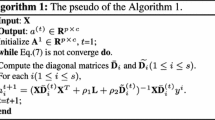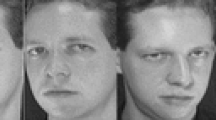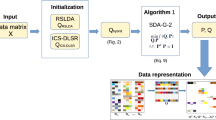Abstract
Based on the classification rule of sparse representation-based classification (SRC) and linear regression classification (LRC), we propose the maximum nearest subspace margin criterion for feature extraction. The proposed method can be seen as a preprocessing step of SRC and LRC. By maximizing the inter-class reconstruction error and minimizing the intra-class reconstruction error simultaneously, the proposed method significantly improves the performances of SRC and LRC. Compared with linear discriminant analysis, the proposed method avoids the small sample size problem and can extract more features. Moreover, we extend LRC to overcome the potential singular problem. The experimental results on the extended Yale B (YALE-B), AR, PolyU finger knuckle print and the CENPARMI handwritten numeral databases demonstrate the effectiveness of the proposed method.
Similar content being viewed by others
References
Li SZ (1998) Face recognition based on nearest linear combinations. In: Proceedings of IEEE international conference on computer vision and pattern recognition, pp 839–844
Li SZ, Lu J (1999) Face recognition using nearest feature line method. IEEE Trans Neural Netw 10(2): 439–443
Li SZ, Chan KL, Wang CL (2000) Performance evaluation of the nearest feature line method in image classification and retrieval. IEEE Trans Pattern Anal Mach Intell 22(11): 1335–1339
Chien J-T, Wu C-C (2002) Discriminant wavelet faces and nearest feature classifiers for face recognition. IEEE Trans Pattern Anal Mach Intell 24(12): 1644–1649
Wright J, Yang A, Ganesh A, Sastry S, Ma Y (2009) Robust face recognition via sparse representation. IEEE Trans Pattern Anal Mach Intell 31(2): 210–227
Naseem I, Togneri R, Bennamoun M (2010) Linear regression for face recognition. IEEE Trans Pattern Anal Mach Intell 32(11): 2106–2112
Jolliffe IT (1986) Principal component analysis. Springer, New York
Belhumeur PN, Hespanda J, Kiregeman D (1997) Eigenfaces vs Fisherfaces: recognition using class specific linear projection. IEEE Trans Pattern Anal Mach Intell 19(7): 711–720
Li H, Jiang T, Zhang K (2003) Efficient and robust feature extraction by maximum margin criterion. In: Proceedings of advances in neural information processing systems, pp 97–104
He X, Yan S, Hu Y, Niyogi P, Zhang H-J (2005) Face recognition using Laplacian faces. IEEE Trans Pattern Anal Mach Intell 27(3): 328–340
He X, Cai Deng, Yan S, Zhang HJ (2005a) Neighborhood preserving embedding. In: Proceedings of the 10th IEEE international conference on computer vision, pp 1208-1213
Yan S, Xu D, Zhang B, Zhang H, Yang Q, Lin S (2007) Graph embedding and extension: a general framework for dimensionality reduction. IEEE Trans Pattern Anal Mach Intell 29(1): 40–51
Yang J, Zhang D, Yang J, Niu B (2007) Globally maximizing, locally minimizing: unsupervised discriminant projection with applications to face and palm biometrics. IEEE Trans Pattern Anal Mach Intell 29(4):650–664
Chen H-T, Chang H-W, Liu T-L (2005) Local discriminant embedding and its variants. In: IEEE conference on computer vision and pattern recognition (CVPR 2005), pp 846–853
Wang F, Wang X, Zhang D, Zhang CS, Li T (2009) marginFace: a novel face recognition method by average neighborhood margin maximization. Pattern Recognit 42(11): 2863–2875
Candès E, Tao T (2006) Near optimal signal recovery from random projections: universal encoding strategies?. IEEE Trans Inf Theory 52(12): 5406–5425
Donoho D (2006) For most large underdetermined systems of linear equations the minimal l1-norm solution is also the sparsest solution. Commun Pure Appl Math 59(6): 797–829
Candès E, Romberg J, Tao T (2006) Stable signal recovery from incomplete and inaccurate measurements. Commun Pure Appl Math 59(8): 1207–1223
Hastie T, Tibshirani R, Friedman J (2001) The elements of statistical learning: data mining, inference and prediction. Springer, New York
Seber GAF (2003) Linear regression analysis. Wiley-Interscience, Hoboken
Ryan TP (1997) Modern regression methods. Wiley-Interscience, Hoboken
Hoerl AE, Kennard RW (1970) Ridge regression: applications to nonorthogonal problems. Technometrics 12(1): 69–82
Hoerl AE, Kennard RW (1970) Ridge regression: biased estimation for nonorthogonal problems. Technometrics 12(1): 55–67
Jolliffe IT (1986) Principal component analysis. Springer, New York
Li H, Jiang T, Zhang K (2003) Efficient and robust feature extraction by maximum margin criterion. In: Proceedings of Advances in Neural Information Processing Systems, pp 97–104
Cover TM, Hart PE (1967) Nearest neighbor pattern classification. IEEE Trans Inf Theory 13(1): 21–27
Lee K, Ho J, Kriegman D (2005) Acquiring linear subspaces for face recognition under variable lighting. IEEE Trans Pattern Anal Mach Intell 27(5): 684–698
Georghiades A, Belhumeur P, Kriegman D (2001) From few to many: illumination cone models for face recognition under variable lighting and pose. IEEE Trans Pattern Anal Mach Intell 23(6): 643–660
The extended YALE-B database: http://www.zjucadcg.cn/dengcai/Data/FaceData.html
Martinez AM, enavente RB (1998) The AR Face Database. CVC Technical Report, no. 24
Martinez AM, enavente RB (2003) The AR Face Database. http://rvl1.ecn.purdue.edu/~aleix/aleix_face_DB.html
Zhang L, Zhang L, Zhang D, Zhu H (2010) Online finger-knuckle-print verification for personal authentication. Pattern Recognit 43(7): 2560–2571
Zhang L, Zhang L, Zhang D (2009) Finger-knuckle-print: a new biometric identifier. In: Proceedings of the IEEE international conference on image processing
The FKP database. http://www.comp.polyu.edu.hk/~biometrics/FKP.htm
Liao SX, Pawlak M (1996) On image analysis by moments. IEEE Trans Pattern Anal Mach Intell 18(3): 254–266
Weilong C, Joo ME, Wu S (2006) Illumination compensation and normalization for robust face recognition using discrete cosine transform in logarithm domain. IEEE Trans Syst Man Cybernet 36(2): 458–464
Gonzalez RC, Woods RE (2007) Digital image processing. Pearson Prentice Hall, Upper Saddle River
Author information
Authors and Affiliations
Corresponding author
Rights and permissions
About this article
Cite this article
Chen, Y., Li, Z. & Jin, Z. Feature Extraction Based on Maximum Nearest Subspace Margin Criterion. Neural Process Lett 37, 355–375 (2013). https://doi.org/10.1007/s11063-012-9252-y
Published:
Issue Date:
DOI: https://doi.org/10.1007/s11063-012-9252-y




